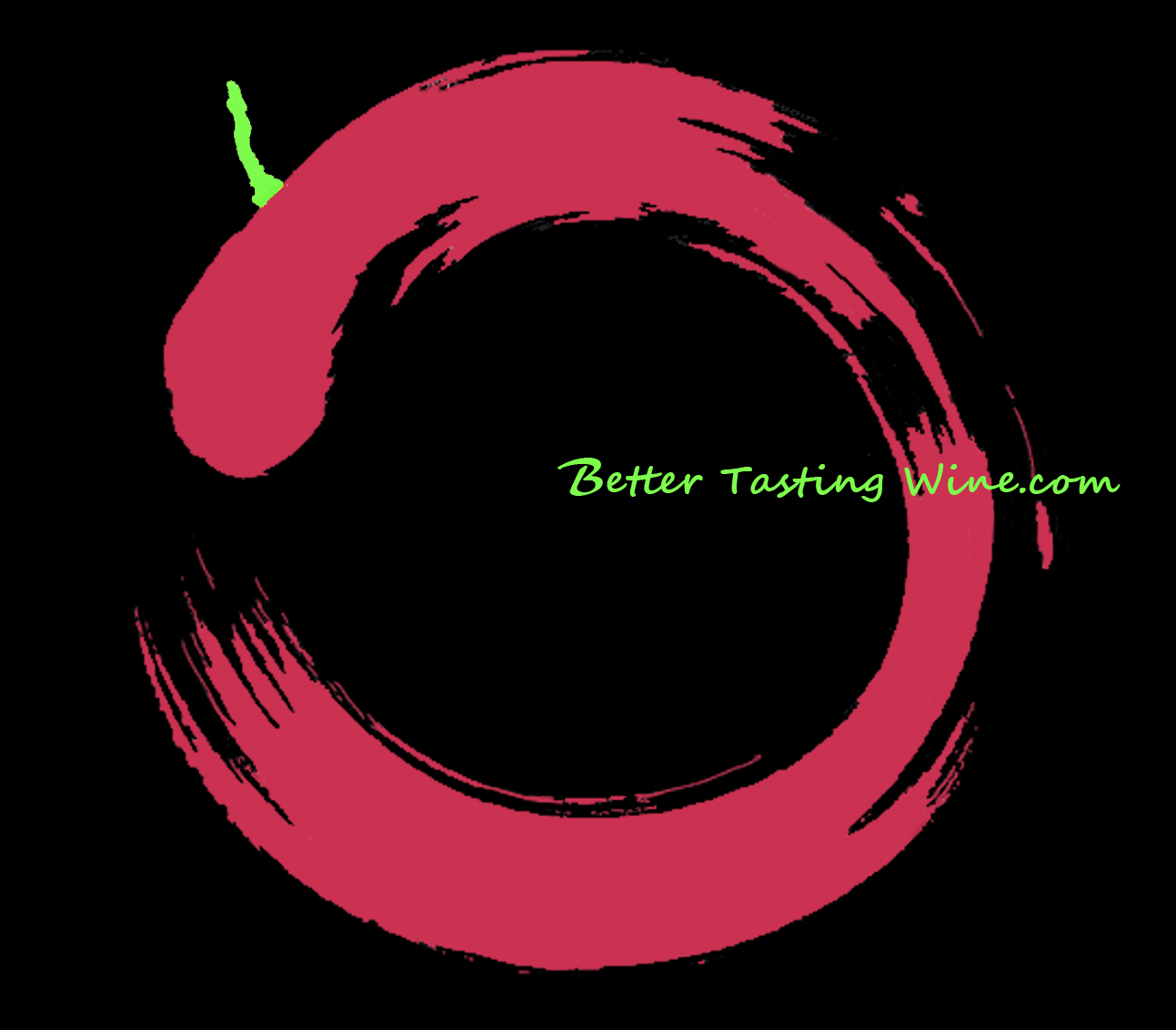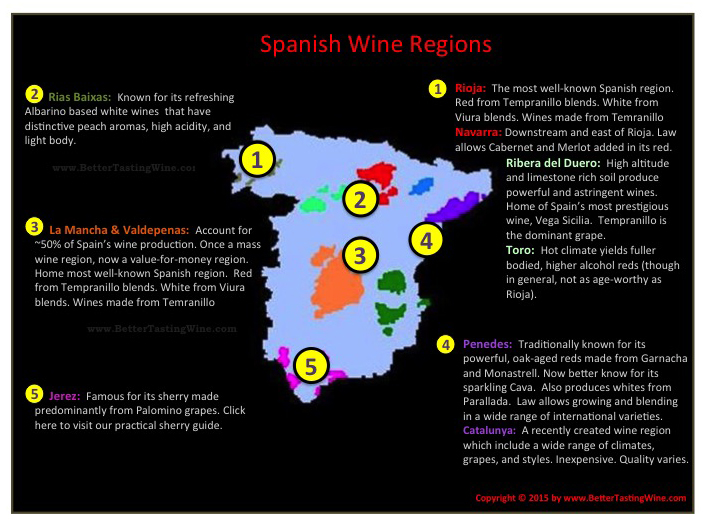Spanish Wines: All you need to Know
|
|
With 1,200,000 hectares, Spain has more land under vine than any other country in the world. However, due to harsh climate, old vine age, and past regulatory constraints, Spain lags behind France and Italy in yields and volume of wine produced. Spain houses many varietals. Tempranillo and Garnacha (Grenache) are widely planted. Grenache, planted widely in Southern France, is actually Spanish in origin. Other varietals include Viura (Macabeo), Albarino, Verdejo, Airen, and Palomino and Pedro Ximenez. Note there there are many local names for the same grape. For example, the massly planted Tempranillo is known as Ull de Llebre in Penedes, Tinto Fino or Tinta Del Pais in Rebera Del Duero, Tinta de Toro in Toro, and Cencibel in Valdepenas! Interactive Spanish Wine Map: Click on the text for a specific region.
Appellation ClassificationsSimilar to France's, Spain classifies wine into tiered quality systems:
Useful Wine Label KnowledgeDO wine must go through a certain period of aging time. Look for the following terms on the wine label to assess the quality and complexity of the wine:
RiojaRioja is the best known Spanish wine region. Tempranillo and Garnacha (Grenache) are its two primary grapes that thrive in its limestone-rich soil and moderate climate environment.
Over 60% of the wine produced in Rioja are "Rioja Joven" and meant to be drunk young. La Rioja Alta is a better known producer who focuses on Rioja Reserves and Gran Reservas. Reliable Producers: Despite one of the two regions qualified to receive DOCa status, the quality of wine is still quite inconsistency. Reliable producers include: Marques de Riscal, Bodegas Muga, La Rioja Alta, Marques de Caceres, Marques de Murrieta, Contino, Finca Allende, and Palacios Remondo. NavarraLies on the east of Rioja, downstream River Ebro, Navarra was once known for its rose wines. In recent years, it is well-known for its aromatic black berry fruit red made from Tempranillo blended with Cabernet and/or Merlot. The law does not allow Rioja DOCa to include Cabernet or other internatinal grapes in its blend. The DOs, Navarra and Somontano, can and have been making wines are international palate friendly in recent years. Ribera del DueroHigh altitude, limestone rich soil, continental climate -- all give the Ribera del Duero reds a more powerful wine with good fruit concentration and astringent tannins. Reliable Producers: Ribera del Duero is the home of Vega Sicilia, Spain's most prestigious producer. While Unico, released after 10-15+ years of aging, commands a high price, the estate also owns and produces two affordable, high quality wines -- Alion in Ribera del Duero and Pintia in Toro. Compared to Ribera del Duero and Rioja, Toro's wines are higher in alcohol (often reaching 14.5%) due to its hot summers. It is fuller-bodied and more mouth-coating, but as a result, does not offer the same aging potential. Rias BaixasAlbarino thrives along the damp, cool Atlantic coast on the north-western part of Spain.
Reliable Producers: Adega Valdes Gundian, Bodegas Zarate El Palomar, Pazo de Galegos, Fillaboa (Seleccion Finca Monte Alto). PenedesOnce known for still wines, Penedes DO allow various varietals including international grapes in its planting and blends. Traditionally known for still wines, now Penedes is highly associated with its sparkling cava.
Quality Producers of Cava include Freixenet and Codorniu. La Mancha & ValdepenasLa Mancha is actually Europe's largest single demarcated wine region, lying in the heart of Spain. The Moors called it "Manxa" or parched earth. As rainfall is unreliable, the drougt-resistant Airen grape thrives as it most widely planted white varietal. Tempranciallo, locally known as Cencibel, is the dominant red grape. La Mancha regulations allow the planting and blending of many international grapes. In recent decade, technology and investment have revived La Mancha, giving it a variety of new exciting wines that are very reasonably priced. Valdepenas is worth a mention. Lying in the south of La Mancha, its name means Valley of the Stones. Sharing a similar arid climate as La Mancha, Valdepenas however has enjoyed a better reputation due to its soft, supple reds. Traditionally they were made from Tempanrillo grapes and aged in olad American oak barrels. In recent years, many producers add international grapes to the blend. JerezJerez is both the name of the town in Spain, as well as the name of the increasingly trendy fortified wine made from white grapes. Sherry has long been misperceived as sweet and for aperitif only. Thanks to such misunderstanding, there are still complex and amazing old sherry in the market at very reasonable price. Visit our Sherry Guide: 12 Commonly Asked Questions. |
Stay informed. Follow us and subscribe here to get our latest wine insider news and tips:
Practical Wine Lessons: Wine Tasting Like a Pro | Grapes | Serving Wine | Food Pairing | Preservation | Temperature | Restaurant Ordering | Wine Labels | Wine Regions | Wine Storage | Start a Collection | Common Wine Myths.
Useful Wine Tips: Ten Facts to Become an Instant Wine Pro | Vintage Guide | Removing a Broken Cork | Serving Order of Wines | Fastest Way to Chill a Wine | Host Wine Party | Elements of a Good Wine | Wine Investment "Winning" Guide | Leftover Wine: Recipe for Vino Punch | Freeze Your Leftover Wine | Wine Moods Pairing | Best Way to Preserve Champagne After Open | Ten Must-Have Wine Accessories.
Tasting Tutorial: Cabernet vs. Merlot vs. Pinot Noir | Sauvignon Blanc vs. Chardonnay vs. Riesling | Burgundy vs US vs New Zealand Pinot Noir.
Fun Download: Wine Tasting Scorecard | Wine Serving Temperature Chart | Wine Aroma Table | 3 Must-Know Red Grapes | 3 Must-Know White Grapes | Vintage Chart | Wine Party Themes | Wine Region Maps | Grand Cru Chart | Wine and Moods Pairing Chart | Wine Quotes & Wine Humor.
Travel & Exploration: Champagne 101 | Bandol | Italy | Spain | Sherry.
Jewels & Gems: Grower Champagne Pierre Gimonnet | Gravner Ribolla - An Amber Wine Maturated in Clay | Gaja - King of Barbaresco.

